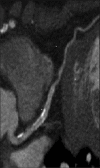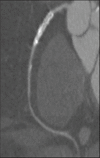The Value of Multi-slice Computed Tomography Compared to Conventional Coronary Angiography for Detecting In-stent Restenosis
- PMID: 28828343
- PMCID: PMC5549549
- DOI: 10.4103/2277-9175.211796
The Value of Multi-slice Computed Tomography Compared to Conventional Coronary Angiography for Detecting In-stent Restenosis
Abstract
Background: Diagnostic value of multi-slice computed tomography (MSCT) for detecting in-stent restenosis in comparison with conventional coronary angiography remained uncertain. The present study aimed to determine the value of MSCT for detecting in-stent restenosis.
Materials and methods: This historical cohort study was included 226 patients with the history of percutaneous coronary intervention from 2000 to 2014 that referred to MSCT Unit at Alzahra Heart Center in Isfahan. The subjects were followed-up by telephone with regard to performing coronary angiography up to 3 months after MSCT and their status about cardiac events.
Results: Among all participants, 63 stents (27.9%) underwent coronary angiography up to 3 months after MSCT that 2 stents in left circumflex artery (LCX) assessment, 2 in left anterior descending (LAD) assessments and none in right coronary artery (RCA) assessment were uninterpretable. Sensitivity, specificity, positive predictive value (PPV), negative predictive value (NPV), and accuracy of MSCT was 92.9%, 66.6%. 92.9%, 66.6%, and 88.2%, respectively for detection of occlusion in LCX stents, 100%, 100%, 100%, 100%, and 100%, respectively for detection of occlusion in LAD stents, and 80.0%, 0.0%, 80.0%, 0.0%, and 66.7%, respectively for detection of occlusion in RCA stents. Overall, MSCT had sensitivity of 93.8%, specificity of 70.0%, PPV of 93.8%, NPV of 70.0%, and accuracy 89.7% for detection of coronary stent restenosis.
Conclusion: MSCT has high diagnostic value for detecting in-stent restenosis. Diagnostic accuracy of MSCT for detecting stent restenosis is considerably different between the coronary arteries with the highest diagnostic values for LAD and the lowest diagnostic values for RCA.
Keywords: Angiography; computed tomography; restenosis; stent.
Conflict of interest statement
There are no conflicts of interest.
Figures
References
-
- Fischman DL, Leon MB, Baim DS, Schatz RA, Savage MP, Penn I, et al. A randomized comparison of coronary-stent placement and balloon angioplasty in the treatment of coronary artery disease. Stent Restenosis Study Investigators. N Engl J Med. 1994;331:496–501. - PubMed
-
- Jensen JK, Jensen LO, Terkelsen CJ, Lassen JF, Tilsted HH, Hansen KN, et al. Incidence of definite stent thrombosis or in-stent restenosis after drug-eluting stent implantation for treatment of coronary in-stent restenosis: From Western Denmark Heart Registry. Catheter Cardiovasc Interv. 2013;81:260–5. - PubMed
-
- Kornowski R, Hong MK, Tio FO, Bramwell O, Wu H, Leon MB. In-stent restenosis: Contributions of inflammatory responses and arterial injury to neointimal hyperplasia. J Am Coll Cardiol. 1998;31:224–30. - PubMed
-
- Shah PK. Inflammation, neointimal hyperplasia, and restenosis: As the leukocytes roll, the arteries thicken. Circulation. 2003;107:2175–7. - PubMed
-
- Chen J, Chen Y, Tian F, Han Y, Jing J, Liu J, et al. Predictors of in-stent restenosis in coronary heart disease patients complicating with diabetes mellitus within 2 years after drug-eluting stents implantation. Zhonghua Xin Xue Guan Bing Za Zhi. 2014;42:14–8. - PubMed
LinkOut - more resources
Full Text Sources
Other Literature Sources



